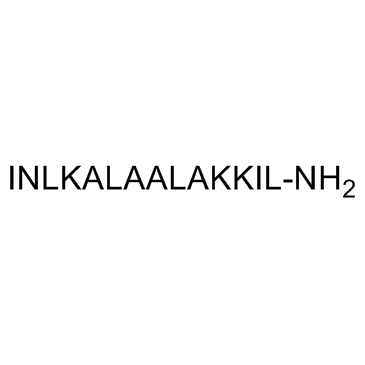Mastoparan trifluoroacetate salt

Mastoparan trifluoroacetate salt structure
|
Common Name | Mastoparan trifluoroacetate salt | ||
|---|---|---|---|---|
| CAS Number | 72093-21-1 | Molecular Weight | 1478.91000 | |
| Density | 1.15g/cm3 | Boiling Point | 1676.8ºC at 760 mmHg | |
| Molecular Formula | C70H131N19O15 | Melting Point | N/A | |
| MSDS | USA | Flash Point | 967.9ºC | |
Use of Mastoparan trifluoroacetate saltMastoparan, a tetradecapeptide which is a component of wasp venom, stimulates release of prolactin from cultured rat anterior pituitary cells. |
| Name | mastoparan |
|---|---|
| Synonym | More Synonyms |
| Description | Mastoparan, a tetradecapeptide which is a component of wasp venom, stimulates release of prolactin from cultured rat anterior pituitary cells. |
|---|---|
| Related Catalog | |
| In Vitro | Mastoparan has an amphiphilic nature and is reported to exert a variety of pharmacological and biochemical effects. Mastoparan induces exocytosis of hormones from anterior pituitary cells. Mastoparan stimulation of prolactin secretion is dose-dependent, time-dependent, reversible and required the presence of calcium. Mastoparan causes translocation of protein kinase C activity from a soluble to a membrane-attached form. Mastoparan is able to increase the intracellular Ca2+ concentration in Fura-2-loaded individual lactotrophs. Mastoparan is also able to interact with GTP-bindmg proteins. Thus, Mastoparan has been shown to facilitate exchange of nucleotides and to stimulate GTPase activity on G-proteins. It has therefore been proposed that the cellular effects of Mastoparan are due to an ability to mimic G-protein-linked agonist-liganded receptors[1]. |
| References |
| Density | 1.15g/cm3 |
|---|---|
| Boiling Point | 1676.8ºC at 760 mmHg |
| Molecular Formula | C70H131N19O15 |
| Molecular Weight | 1478.91000 |
| Flash Point | 967.9ºC |
| Exact Mass | 1478.01000 |
| PSA | 568.56000 |
| LogP | 7.00350 |
| Appearance of Characters | white |
| Index of Refraction | 1.525 |
| InChIKey | MASXKPLGZRMBJF-HDSAQESISA-N |
| SMILES | CCC(C)C(N)C(=O)NC(CC(N)=O)C(=O)NC(CC(C)C)C(=O)NC(CCCCN)C(=O)NC(C)C(=O)NC(CC(C)C)C(=O)NC(C)C(=O)NC(C)C(=O)NC(CC(C)C)C(=O)NC(C)C(=O)NC(CCCCN)C(=O)NC(CCCCN)C(=O)NC(C(=O)NC(CC(C)C)C(N)=O)C(C)CC |
| Storage condition | −20°C |
| Water Solubility | H2O: 1 mg/mL, clear, colorless |
| Personal Protective Equipment | Eyeshields;Gloves;type N95 (US);type P1 (EN143) respirator filter |
|---|---|
| Safety Phrases | S22-S24/25 |
| RIDADR | NONH for all modes of transport |
| WGK Germany | 3 |
|
~75% 
Mastoparan trif... CAS#:72093-21-1 |
| Literature: Saito, Kazuki; Higashijima, Tsutomu; Miyazawa, Tatsuo; Wakimasu, Mitsuhiro; Fujino, Masahiko Chemical & Pharmaceutical Bulletin, 1984 , vol. 32, # 6 p. 2187 - 2193 |
|
Axon targeting of the alpha 7 nicotinic receptor in developing hippocampal neurons by Gprin1 regulates growth.
J. Neurochem. 129(4) , 649-62, (2014) Cholinergic signaling plays an important role in regulating the growth and regeneration of axons in the nervous system. The α7 nicotinic receptor (α7) can drive synaptic development and plasticity in ... |
|
|
The chloroplast calcium sensor CAS is required for photoacclimation in Chlamydomonas reinhardtii.
Plant Cell 23(8) , 2950-63, (2011) The plant-specific calcium binding protein CAS (calcium sensor) has been localized in chloroplast thylakoid membranes of vascular plants and green algae. To elucidate the function of CAS in Chlamydomo... |
|
|
Identification of the thiol isomerase-binding peptide, mastoparan, as a novel inhibitor of shear-induced transforming growth factor β1 (TGF-β1) activation.
J. Biol. Chem. 288(15) , 10628-39, (2013) TGF-β1 is a disulfide-bonded homodimeric protein produced by platelets and other cells that plays a role in many physiologic and pathologic processes. TGF-β1 is secreted as an inactive large latent co... |
| ILE-ASN-LEU-LYS-ALA-LEU-ALA-ALA-LEU-ALA-LYS-LYS-ILE-LEU-NH2 |
| INLKALAALAKKIL |
| INLKALAALAKKIL-NH2 |
| Mastoparan |
| MASTOPARAN VESPULA LEWISII |
| PE PTIDE FROM WASP VEN |
| MFCD00076865 |
| H-ILE-ASN-LEU-LYS-ALA-LEU-ALA-ALA-LEU-ALA-LYS-LYS-ILE-LEU-NH2 |
| MASTOPARAN 4ACOH 6H2O |


